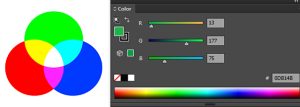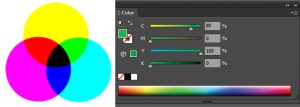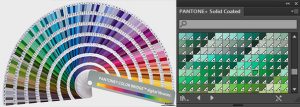Please match as close as you can to an apple green. Our colour is similar to a dark navy, can you do that? We want our banner to be a sky blue. Our Artwork Department are asked questions like these everyday. The tricky thing is, that there is a lot more to colour management than you might think. While a colour you see on screen might be the perfect sky blue you are searching for, it is almost guaranteed that when printed it will look nothing like the colour you approved on screen.
In the colour world, there are three main colour systems: RGB, CMYK & PMS. It is very possible that you have heard these terms before. It is even more possible that you have no idea what each of these acronyms stand for and which is the most suitable for each format in the design industry.
While it might not seem that important, if you want your final design to look the way you intended, it is vital that you know how each of these colour systems work and how they differ. Here we break it down for you.
 RGB (Red Green Blue).
RGB (Red Green Blue).
RGB is a colour system used exclusively in digital design. It is the colour system used by computer screens to reflect colour by blending light itself. When building a website, or designing an electronic invitation or promotion you will need to provide your designer with the RGB profile of your logo.
 CMYK (Cyan, Magenta, Yellow and Black)
CMYK (Cyan, Magenta, Yellow and Black)
CMYK is the colour system we use for printing. It refers to the four colours used in process colour printing. In process colour printing the colours you see are created by combining different percentages of each of these four colours. When printing an invitation, promotion or banner you will need to supply the CMYK profile of your logo to your printer.
What is the difference?
The RGB colour system has a much broader spectrum of colour than a the CMYK system. Computer monitors and printers see colour in contrasting ways. This is why colours you see on your screen look vibrant and energetic while those printed on paper and fabric look dull in comparison.
While every printer prints using CMYK, it is important to realise that the colour gamut of every printer is different. The final colour result varies depending on the printer that is producing it and the material you are printing on. For example; a CMYK logo printed by Printer A onto glossy paper will not print identical to the same CMYK logo printed by Printer B on a banner fabric. Additionally a logo printed on glossy paper by Printer A and Printer B using the identical CMYK profile is NOT guaranteed to match in colour once printed.
Why? Because every printer is calibrated differently; and all materials absorb and reflect light differently. This is why the Pantone Matching System was developed.
PMS (Pantone Matching System)
PMS colours are a universal list of specific colours printed onto a colour matching swatch book. By selecting a PMS colour for your logo, you will ensure your chosen printer will select the correct percentage of each of the four process CMYK colours. The final result will perfectly match your specified PMS colour.
The Art of Colour Management
The colour management of all of these systems is complex. Sometimes you are lucky. You buy a new ink jet printer, you hook it up, and your prints come out looking fantastic and continue to do so for the lifespan of that machine. But the reality is that having complete control of the output your $29 Kmart printer will have is far from guaranteed.
ExpandaBrand has become the industry leader in the field of colour, fabric and high-tech inks. We have spent a lot of time, travel and effort to get to where we are today. We think that we are almost unmatched in achieving our clients expectations in our colour duplication on our Teardrop Banners, Retractable Banner Stands and Printed Marquees. We go to extreme lengths to guarantee colour accuracy on our fabric advertising flags and pride ourselves on customer satisfaction.
Need further information? Call us today and we will explain it all for you.



